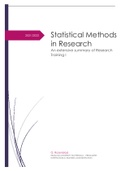Summary
☆Super Extensive Summary of Research Training I☆ Combined transcription of all the online lectures and pdf pages!
- Course
- Institution
This document contains a combination of the transcription of all the online lectures (excluding the tutorials!) and the pdf pages of Research Training I of the Premaster IBA at RSM. I made this because I find it easier to read than to listen to. I figured this would be very useful for other student...
[Show more]



